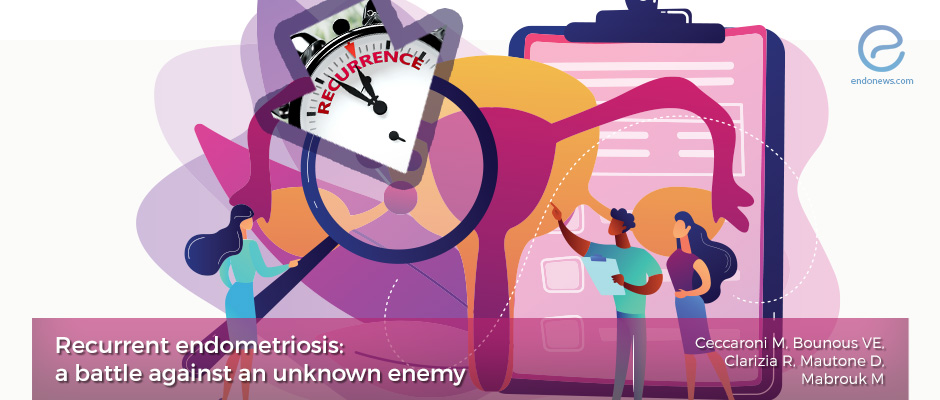Recurrent endometriosis is a real challenge both for the patients and clinicians
Nov 18, 2019
Although there is no standardization in the definition of endometriosis recurrence and the incidence is not known exactly, it is encountered frequently after the management of endometriosis.
Key Points
Highlights:
- If the definition and confounding factors that may influence the rate of endometriosis recurrence are identified, its prevention and management would become possible.
Importance:
- Personalized management and follow-up should be performed in patients with endometriosis considering patient disease-related and surgery-associated risk factors.
What’s done here?
- This review includes the recent literature in the MEDLINE database using the Medical Subject Heading terms “endometriosis” and “recurrence”.
- A total of 392 human studies about this topic since 1990 with the available full text were reviewed.
- For this purpose, 80 studies were decided to be included by the identification of further potentially relevant studies from the references of the selected studies.
Key results:
- Based on the included studies, the incidence of endometriosis recurrence changed between 0% and 89.6%.
- Although there was a dilemma for the definition of endometriosis recurrence, several confounding factors in recurrence rates were clarified which would be beneficial for the prevention and management of the disease.
- Endometriosis recurrence was defined as the recurrence of pain or as a significant increase in serum CA125 levels or as a surgical finding during repeat surgery.
- The severity of dysmenorrhea, dyspareunia or pelvic pain with or without clinical signs or instrumental evidence were at least equal or more in women with recurrent endometriosis.
- Pelvic fibrotic areas and tender nodules were considered as suspicious clinical findings of endometriosis recurrence.
- Endometriomas with at least 2 cm in size and typical ultrasonographic appearance were accepted as recurrent endometriomas.
- The length of follow-up, the design and the sample size of the study, the type and stage of the disease, the type of surgery and the use of postoperative medical treatment were considered as confounding factors.
- While young age, having positive family history and high body mass index, previous use of drugs for ovarian stimulation, presence of large endometrioma at diagnosis, severe preoperative pain and high serum CA125 level, advanced stage of disease were patient disease-related risk factors, the intraoperative findings of extensive adhesion and the need for radical surgery and positive surgical margins were surgery-associated risk factors for endometriosis recurrence.
Lay Summary
Endometriosis is defined as the localization of endometrial stromal and glandular cells outside the uterine cavity. Current medical and surgical treatment options have several limitations including the side effects, costs, risk of recurrence, effects on conception capability.
Recurrence is a major problem that can be encountered at various rates in different publications. It can occur due to the development of de novo lesions or to in situ growth of residual foci.
Ceccaroni et al, a group of scientists from Italy, published a review titled “Recurrent endometriosis: a battle against an unknown enemy” in the journal named "The European Journal of Contraception & Reproductive Health Care". These authors tried to clarify different definitions of endometriosis recurrence in articles with available full text in the MEDLINE database with the terms of “endometriosis” and “recurrence” published since 1990. They decided that the definition of endometriosis recurrence has been identified in different publications depending on pain recurrence, clinical findings, anatomical relapse, a significant increase in serum CA125 levels or second-look surgery.
However, each definition has several limitations, under- or overestimations. They stated that there are possible confounding factors contributing to endometriosis recurrence. These are the length of follow-up, the design and the sample size of the study, the type and stage of the disease, the type of surgery and the use of postoperative medical treatment are considered as confounding factors.
While young age, having positive family history and high body mass index, previous use of drugs for ovarian stimulation, presence of large endometrioma at diagnosis, severe preoperative pain and high serum CA125 level, advanced stage of disease are patient disease-related risk factors, the intraoperative findings of extensive adhesion and the need for radical surgery and positive surgical margins are surgery-associated risk factors for endometriosis recurrence.
The authors emphasized the importance of prediction of recurrence risk in women with endometriosis for the future management of the disease and they recommended the surgeons to describe endometriosis recurrence based on a standardized definition.
“Further randomized controlled trials with large sample sizes and long follow-up years, documenting endometriosis recurrence according to a standardized method, are required to better investigate the recurrence of endometriosis.” the authors added.
Research Source: https://www.ncbi.nlm.nih.gov/pubmed/31550940
endometriosis endometriosis recurrence dysmenorrhea pelvic pain laparoscopy confounding factors

